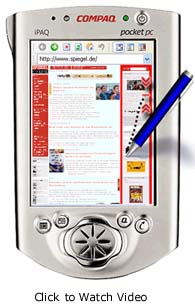Squeeze the Screen
by Suzanne Ross
Collapse-to-Zoom Co-Authors
If you've never seen some of the ingenious ways that
researchers have invented to make viewing data on a small
screen easy, you might say, "I'll never do all my computing on
a PDA or Smartphone." You might concede that it would be nice,
handy even, but refuse to believe that it's practical.
Patrick Baudisch is one of the researchers who could
convince you otherwise. An expert in the human-computer
interaction field, Baudisch is exploring how to shrink large
amounts of content into a small space and keep the content
useful.
One of his projects, called Fishnet,
takes two known techniques and combines them to come up with a
solution for Web page browsing on a small device.
"Fishnet combines fisheye views with search and
highlighting. Search and highlighting is currently available
for desktop machines using MSN Toolbar," said Baudisch.
Fishnet shows you a focus area that is clear and readable,
and compressed content areas at the top and bottom of the page
overlaid with different colored highlighted search terms that
direct you to relevant content.
"It's interesting because the compressed areas of fisheye
views by themselves aren't too readable. Combining them with
search term "popouts", however, is like a semantic zoom and
makes the page useful to you. If I did not have the search and
highlighting, all I would see would be some squished text at
the bottom that was unreadable. By using popouts to highlight
all search terms contained in the page, Fishnet makes use of
all available screen space and assures that the most relevant
information is preserved."
"We ran a study and found that for pages containing search
terms, Fishnet made people twice as fast at finding out that a
page is relevant."
Another project that Baudisch has worked on to improve
accessibility for small screens is called Collapse-to-Zoom.
Baudisch reported on this project at the 17th annual User
Interface Software and Technology (UIST) Symposium on October
25.
Since Web pages are designed with the desktop in mind, they
don't often have a layout that works well on small screens.
They often use multi-column views that complicate navigation.
Users have to scroll horizontally and vertically to read the
page. Some cures for this involve throwing all the content
into one long column, but this requires quite a lot of
vertical scrolling. Scrolling through the menus and sidebars
can take up to several screens on a PDA.
 Baudisch and his colleagues
have devised a project called Collapse-to-Zoom
that avoids all that annoying scrolling. Collapse-to-Zoom
allows users to collapse the areas of the screen that they
aren't interested in, which causes the areas of relevant
content to expand. It then allows users to zoom in on the
content they want to read. Users typically collapse archive
material, ads, or menus to focus on content.
Baudisch and his colleagues
have devised a project called Collapse-to-Zoom
that avoids all that annoying scrolling. Collapse-to-Zoom
allows users to collapse the areas of the screen that they
aren't interested in, which causes the areas of relevant
content to expand. It then allows users to zoom in on the
content they want to read. Users typically collapse archive
material, ads, or menus to focus on content.
Users can navigate the Collapse-to-Zoom interface using a
stylus. The menu is based on a novel technique that the
researchers call a marquee menu. Dragging the pen on the
screen selects a rectangular section that encloses the start
and end points of the drag gesture and simultaneously selects
a command, based on whether that selection was created by
dragging up or down. Compared to existing pen languages that
use separate gestures from selection and command, a marquee
menu is simpler and faster. The Collapse-to-Zoom navigation
allows users to expand or collapse columns, to collapse entire
columns, to expand and zoom on selected content, and to follow
links by tapping the screen.
Baudisch believes that this research will not only help
computer geeks get more work done, but it will help people who
rely on mobile devices as their only connection to the
Internet.
"We think of mobile devices as something that will get us
from our computer at home to our computer at work," said
Baudisch. "But in rural areas throughout the world, such as
parts of India, very few people have access to desktop
computers. However, an increasing number of these people are
getting access to cell phones. For many of them, an
intelligent cell phone will be the only means for accessing
the digital world. We are working on a whole range of projects
aimed at making this easier."